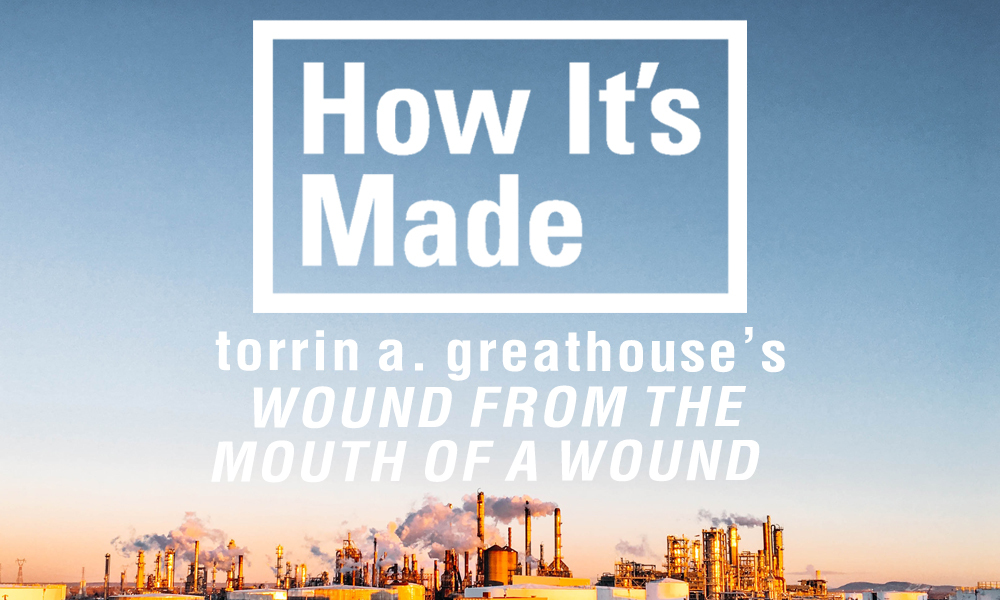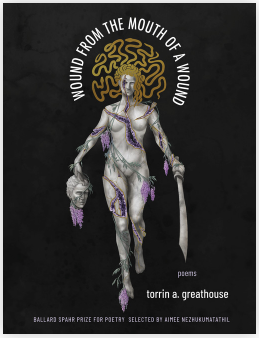How It’s Made: WOUND FROM THE MOUTH OF A WOUND by torrin a. greathouse

We’re so happy to have had the chance to look under the hood of torrin a. greathouse’s highly anticipated debut, WOUND FROM THE MOUTH OF A WOUND (released TODAY from Milkweed Editions). The book “feels like we’re holding a small thunderstorm in our hands,” says poet Aimee Nezhukumatathil. With our How It’s Made series, we endeavor to take away some of that ever-present mystery of how a collection like this one comes to being.
What were the most joyful moments of WOUND FROM THE MOUTH OF A WOUND’s journey to publication?
There are two that come to mind. The first, more recently, was seeing the book’s finished cover for the first time. If I’m being totally honest, nothing about the publication process felt entirely real until that moment. But seeing the gorgeous cover that Milkweed Editions’ art director and the artist Cael Lyons had collaborated on, it all finally clicked. That image of Medusa, like something pulled straight out of my brain, but also with so many beautiful details and flourishes I never could have imagined.
The other big joy that jumps out to me, was finally figuring out the burning haibun form. I knew that I wanted to integrate elements of erasure into the haibun, a form I already loved, as a way of exploring the concept of interior landscapes, but it took me over a year to figure out a working version of the form. The first-ever burning haibun, which was published here in Frontier Poetry, was—at the time—the most heavily revised poem I had ever written, pared down from the initial messy, four-page draft, which featured six different stages of erasure before the final haiku. Funny enough, I think that the only line preserved from that first attempt, after nearly two dozen drafts, was the opening sentence: Once, my mother accused me of throwing alcohol & gasoline on my emotions. An actual quote from my mother that I refused to write into a line for years until that poem demanded to hold it.
What was the favorite piece of media, literature, or art you consumed while writing these poems?
Favorite is such an impossible modality for me, especially because I have been so many people in the course of writing this collection, and am a slightly different person now. Call that the biology, quantum mechanics, philosophy, whatever of it. What I do know is the things that I returned to the most.
If I had to narrow it down to just one book, ever-present during the writing and editing this collection, it would be Ocean Vuong’s Night Sky with Exit Wounds. As a young poet, before ever having access to a “formal poetic education,” I taught myself to write through loving imitation of his attentiveness to the breath and line. A practice that began a, perhaps life-long, love and obsession with the craft of the line. And still, each time I reread it, Vuong’s work opens something new to me.
As someone who often writes, or edits, with music in the background to drown out my ambient thoughts, there were a few albums that became constant companions throughout the process of this manuscript: Against Me!’s Transgender Dysphoria Blues; The Wonder Years’ Sister Cities and The Greatest Generation; and Milo’s who told you to think??!!?!?!?! Of the three, I think my writing is likely most influenced by Laura Jane Grace of Against Me!’s lyrical style. Her tracks unflinching sincerity, juxtaposed by sudden barbs of sarcastic critique, hold visible lineage in several throughout the collection.
Lastly, while I wouldn’t claim it had an influence on my poetics, Thor: Ragnarok became my go-to-feel-good movie during rough times and the crunch of MFA applications. I’ve probably genuinely watched that movie more times than any other movie on earth. Like, at least fifty times. I can’t even watch it anymore. It stopped being funny. Which is sort of sad to me, in a small and strange way.
How has the pandemic altered the debut process of this collection? Anything you are looking forward to when everything returns in-person?
As a disabled poet, debut aside, the COVID-19 pandemic has been a complicated period. There is so much precarity, for myself, and for all disabled people (and trans people) caught up in the medico-industrial complex. Where pursuing continued care also means potential risk.
At the same time, it has been wonderful to see all the new digital spaces emerging in the literary world, many of which are slowly integrating accessibility features such as reading copies of writers’ work, CART captioning, and ASL interpretation. One week in July, I was able to attend three events in four days. Something that, had I done it in-person, would have left me in severe pain, possibly struggling to stand.
Yet, these events also serve as a reminder that this kind of accessibility was always possible, despite what disabled writers have been repeatedly told. I sincerely hope that when there is a vaccine and in-person events become more commonplace again, these same organizations don’t forget about the frameworks they created, and that accessibility for disabled people isn’t abandoned the moment it becomes less convenient. That large conferences like AWP reflect on, and reckon with, their history of ableism and make major shifts in how they operate. That when people talk about things going “back to normal” they don’t forget who the old normal harmed and excluded.
With all that said, selfishly, the thing that I’m maybe looking forward to most, once in-person events are safe, is the chance tour with this book and to attend all the fellowships and residencies that were delayed due to COVID-19. For all the joys involved in this process, there is, in some ways, a withholding of other joys. One of the many beauties of releasing a book is the chance to travel and spend time with friends, mentors, and poets who I might not otherwise be able to. The knowledge that my poems might carry me across that physical distance. This possibility hasn’t vanished but is—for now—more distant.
What’s your one sentence piece of advice for poets currently putting a collection together?
When organizing the poems in your collection, be attentive to the relationships between first and last lines—of poems, of sections, of the book itself—and how they can be used to shape our journey through the collection.
torrin a. greathouse is a transgender cripple-punk and MFA candidate at the University of Minnesota.
You can find her collection here.
